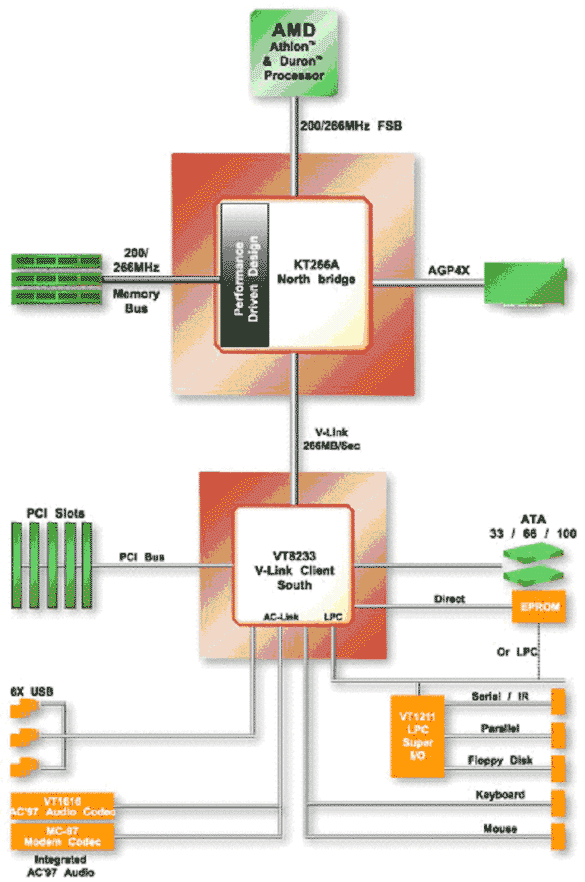Accelerating Athlon: VIA Releases KT266A Chipset
Apollo KT266A - What's New?
When you look at the above block diagram of VIA's new KT266A chipset and compare it to the one of Apollo KT266, you won't spot a whole lot of new stuff. The only new thing is this black shape painted inside of KT266A's north bridge, called 'Performance Driven Design'. This name doesn't really give a whole lot of insight and it could be replaced with 'SiS735 Driven Design' as well. It basically boosts the rather low memory performance of the original KT266 to values that are more than impressive, as you will see below. Let's have a look at the details provided by VIA:
- Enhanced Memory Controller With Performance Driven Design: The VIA Apollo KT266A features an enhanced memory controller, designed with exceptionally high performance in mind. Supporting DDR200/266 memory, the VIA Apollo KT266A provides lightning fast access to system memory. Timings have been improved, resulting in faster transfers between the synchronized Front Side Bus and Memory Bus. Also, the new memory controller with Performance Driven Design can burst up to eight Quad Words of data per clock, up from four in previous designs. Data queues have also been deepened, allowing faster and access to buffered data. The end result is the industry's fastest DDR memory controller.
- V-MAP: The VIA Apollo KT266A is part of the family of VIA Modular Architecture Platforms (V-MAP). As a modular solution, the North and South bridge of VIA Apollo KT266A are completely pin compatible with current and future products, such as the VT8233C South Bridge with integrated 3Com Ethernet MAC, and the upcoming KM266 North Bridge with integrated S3 graphics. V-MAP allows flexibility when designing a system around the VIA Apollo KT266A chipset, enabling OEMs and System Integrators to reach different market segments with a single platform.
- High-Speed V-Link Hub Architecture: The VIA Apollo KT266A makes use of VIA's V-Link Hub Architecture, which provides a dedicated 266 MB/s bus between the North and South bridge. Less advanced chipsets use the 132 MB/s PCI bus as a link, which must be shared with all PCI peripherals.
- 200/266 MHz DDR Front Side Bus Support: The VIA Apollo KT266A supports the AMD Athlon(/Duron( S2K system bus, running at up to an effective 266 MHz. Offering up to 2.1 GB/s of bandwidth, the 266 MHz system bus perfectly complements the high performance DDR memory subsystem and V-Link bus.
- AGP4X/2X Support: Providing up to 1 GB/s in graphics bandwidth with AGP4X technology, the VIA Apollo KT266A supports the latest in video card technology. Additionally, it does not sacrifice AGP2X compatibility like less advanced chipsets, allowing low cost graphics products to be paired with low priced Athlon(/Duron( systems.
The list contains two important items. First of all, VIA was finally able to tweak the memory performance of KT266 with the implementation of several improvements of the memory controller. Unfortunately VIA is not giving any proper details, but you will see that the results below speak for themselves.
The other important feature of KT266A is hidden behind 'V-MAP'. KT266A will be fully pin-compatible with its predecessor KT266, which means that motherboard makers can continue to use the PCBs (printed circuit boards) of the previous KT266-boards. This should ensure very early shipments of KT266A platforms to OEMs and retailers. V-MAP is also allowing the replacement of the current VT8233 south bridge with the VT8233C chip that adds a built-in 100/10 Mbs network MAC. It depends on the motherboard maker and the specs of the board which south bridge will be used.
The Test Motherboard
VIA supplied us with their reference platform VT5577A, which is a Micro-ATX sized board. There is not much to say about the board, except for the fact that it didn't pose any stability issues or other problems while we tested it.
Benchmark Setup
| Hardware | |
|---|---|
| CPU | AMD Athlon 1333 MHz (133 MHz FSB) |
| Motherboard 1 | MSI MS-6341 (AMD 760) |
| Motherboard 2 | MSI MS-6380 (KT266) |
| Motherboard 3 | VIA VT5577A (KT266A) |
| Memory | 2x 128 MB DDR-SDRAM, CL2, 133 MHz Micron |
| Graphics Card | GeForce 3Memory: 64 MB DDR-SDRAMMemory Clock: 460 MHzCore Clock: 200 MHz |
| Hard Drive | 30 GB (IBM 307030)UDMA100 7200 RPM, 2 MB Cache |
| Drivers and Software | |
| IDE (AMD&VIA) | VIA 4 in 1 Version 4.32 FINAL |
| AGP (AMD) | Miniport Driver 4.80 (Windows 98SE)Miniport Driver 5.22 (Windows 2000) |
| AGP (SIS735) | Version 1.06 |
| Graphics Card Driver | Detonator 4 Series V20.80 |
| DirectX Version | 8.0a |
| Operating System | Windows 98 SE, Version 4.10.2222 A |
| Benchmarks | |
| Quake III Arena | Retail Version 1.16command line = +set cd_nocd 1 +set s_initsound 0Graphics detail set to 'Normal'Benchmark using 'Q3DEMO1' |
| 3DMark2001 | Version 1.1 default |
| SiSoft Sandra 2001 | te Pro |
| Aquamark | V2.2 DirectX 8, T&L, Pixel & Vertex ShaderPixel Shader = NO |
| Sysmark 2000 | Patch 5 |
| Unreal Tournament | V4.26 "UTBench" |
| Evolva | V1.2 Build 944 (Dot Bump) |
| Dronez | Row 22 - Cell 1 |
| 3DMark 2001 Pro | Build 200 |
| Vulpine | GLmark |
Get Tom's Hardware's best news and in-depth reviews, straight to your inbox.

